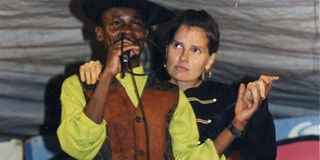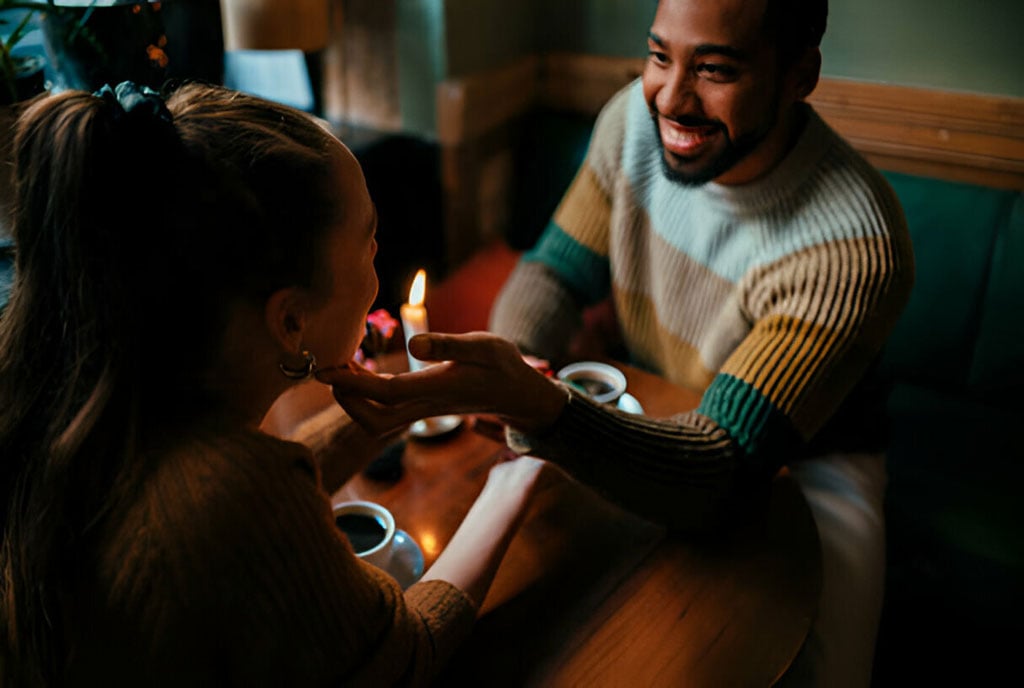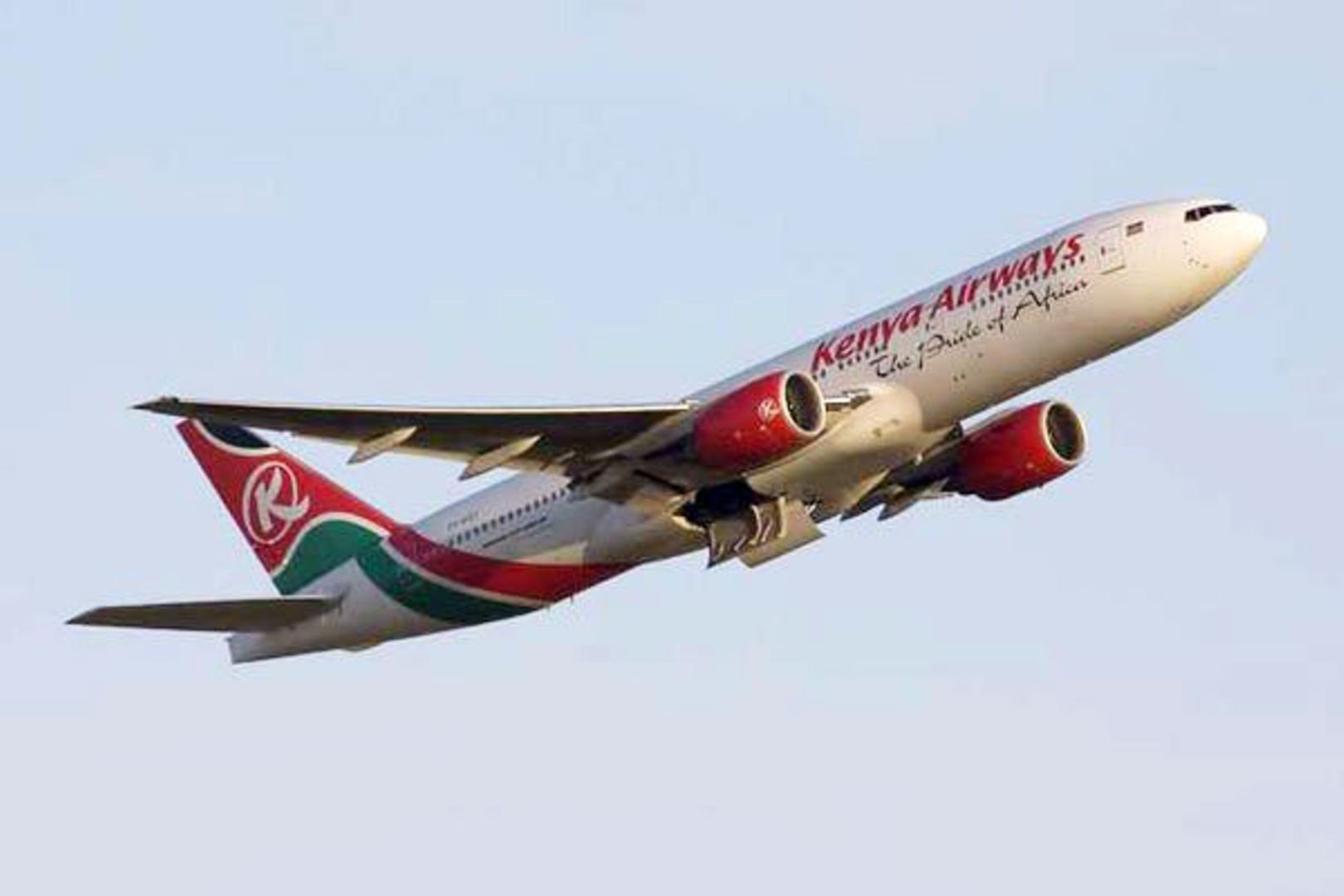My life with Paul Kafeero: One woman tells her intriguing story

Kafeero on the stage with Kathryn Barret-Gaines. The two travelled across the country and even overseas to perform the song Omwana W’Omuzungu which always attracted crowds. File Photo.
What you need to know:
Although Paul Kafeero never married Kathryn Barrett-Gaines, commonly known as Omwana W’omuzungu, the two were very close and lived together. In her book One Little Guitar, she tells the story of how they met, fell in love and how he remains in her reverend.
On January 13, Professor Kathryn Barrett-Gaines, known to many Ugandans as Omwana W’omuzungu launched a book, One Little Guitar, in tribute, to the famous Kadongo Kamu singer, Paul Kafeero. The book that costs Shs50,000 documents all his music and in lyrics; both in Luganda and English.
It is also enriched with lots of photographs, most of them never-seen-before, of the musical prince, right from 1989 when he cut his musical teeth, to his shows here and in the Diaspora.
If music is food to the soul then Paul Job Kafeero’s music provided more than just a meal for local souls. He provided food for thought too, in his clever, elaborative and unadulterated lyrics that make him one of the finest musicians to have graced the stage.
He has been gone from the scene for a good five years, but Kafeero is ironically more influential today than when he lived.
At only 38, he was a musician in the sense of the word- a gifted vocalist, lyricist and guitarist, three musical traits that made him an undoubted gem of his time. From his base in Lweza, off Entebbe road, he penned witty songs with punch, songs that cut through.
Kadongo Kamu is to Uganda what Genge is to Kenya, Kwaito to South Africa or Bongo Flava to Tanzania. This is Uganda’s native music genre, possibly the oldest mainstream music genre in the country. Like the name suggests in the Luganda, kadongo kamu means “one little guitar”.
Music certainly defined Kafeero’s life and he gave it his all.
In a song like Walumbe Zzaya (Mr death, the destroyer) he deals with the dreaded subject in a lengthy yet conversational manner using a richness in words to portray the sadness.
In fact, it was for this song that Kafeero was christened the Golden Boy of Africa, after winning the gold medal from the Institute d’Etudes Theatreales at the Cairo Music Festival of 1994.
His love for the bottle
Most of his musical contemporaries and friends acknowledge that he was a gifted singer. Of course they knew his love for the bottle. He was easier to hang around when he had a bottle in his hands and was sipping its frothy content. He admittedly sings as much in his 2003 hit song Dipo Naziggala, a song that won him recognition back home, at that year’s Pearl of Africa Music (PAM) Awards for best Kadongo Kamu single.
In the song he goes on and on about the woes of alcoholism using idioms, sayings and proverbs.
But that is what Kadongo Kamu allowed this artiste do, use music accompanied by a single instrument or two to talk about the ills in society, share his love stories, deal with domestic issues, advise the parentless and tackle real life issues.
In an enthralling and deeply emotive 10 and half minutes, the maestro goes on to talk about the agony of betrayal by those close to him, loneliness in a dark house with no family or friends and the lies and misjudgment that would be told and made about it.
On May 17, 2007, death robbed Paul Job Kafeero of a life in which he had painfully sung about the ultimate end. The news of his death swept Uganda like a wild bush fire in Uganda and among Ugandans in the Diaspora as well as other music lovers who knew or had heard of him.
“I had 17 missed calls on my cell phone in the US on the morning of May 17, 2007. Because of the time difference between Uganda and America, Kafeero died while I slept,” Barrett-Gaines recalls.
“Since then, he has come to me many times in my dreams, to explain things to me. The missed calls were from his sons. ‘When are you coming?’ Schwarz asked me. So I came, and since then and from now on, when I am on holiday from my teaching position at University of Maryland, I live with Kafeero’s children at the home he built in Kajjansi-Lweza. The only thing we lack is that special spark that is Kafeero’s presence,” she adds.
Barrett-Gaines was one of the people that gave Kafeero mileage and musical capital. Many music lovers and lay people thronged shows to see “this white woman” who he so lovingly sang about.
Getting her to be Omwana W’Omuzungu was the work of two friends of Kafeero, Andrew Benon Kibuuka and Charles James Ssenkubuge who had interacted with the professor as she did her research.
“I was the first to train Omwana W’Omuzungu in performance. I even wrote the words of the song sung by Kathryn,” Kibuuka recounts.
She was eager to perform with this local star and actually precisely recalls the experience, “Thousands of people screaming. I made them laugh and scream more. I put on a gomesi and knelt to greet him. The crowd loved it. It was a great show.”
She went places with Kafeero, as far as London and crowd followed the duo, many to prove for themselves that this white lady could actually sing in Luganda. This included officials from Buganda kingdom who are captured in a photograph dated October, 25, 1998, at Nakivubo Stadium. She later went on to record songs with Kafeero.
Learning Luganda
I ask Barrett-Gaines how she learnt Luganda. “I began studying Luganda at Stanford University in California as I prepared for my Ph.D research in African history. I had a Muganda teacher at Stanford. Then I continued studying Luganda at Makerere Institute of Languages when I shifted to Uganda to live there for the years I was to do research,” she explains.
Luganda was not difficult because she had been studying Swahili for five years. She adds, “The Bantu structure of Swahili prepared me for the Bantu structure of Luganda. But most important, teachers of Luganda are my friends and family in Uganda. The only way to learn Luganda is to live in Buganda.”
Robinah Namatovu Bisirikirwa sung with Paul Kafeero for some time. She says she co-wrote Omwana W’omuzungu with him.
“The first woman to be used was Glay Joan, who was a girlfriend to Shanks Vivi Dee. She was a half caste who was identified at a gig in Masaka. Revellers complained that Kafeero was singing about a white woman but was performing with a half-caste. Ssenkubuge and Kibuuka were Kafeero’s friends and they offered to find him a white woman and that’s how Kathryn came into the picture,” Bisirikwa explains. She says they paid her Shs500,000 for writing the song.
For Barrett-Gaines, this was a song whose lyrics sunk into her heart and it turned out to be love at first sight. She recalls the first time she met Kafeero.
“We met under a huge stage at Nakivubo Stadium on October 25, 1998. I was there to play the role of Omwana W’omuzungu for his new hit song. Two brokers had booked me to play this role for a big Kafeero/Sebatta show. He came off stage to inspect me. He approved of me and I went on stage as his wife,” she recollects.
From then on she says her life changed forever. “He slipped into my heart on that Sunday afternoon at Nakivubo Stadium, and he remains there now. I will always love Paul Kafeero,” she writes in her book.
The song and stage antics brought her fame. “This is the title called to me as I make my way through the streets and taxi parks. This is what I hear behind me at the airport and in the hair salon. I have long accepted that title, and now I cherish it,” she explains.
What started as a dramatic stunt slowly began bonding a local artiste from Kyaggwe and a professor from Virginia, USA. Kafeero who was initially cautious when he started performing with Barrett-Gaines became comfortable with time. Soon, the two would show intimacy as they sung the song.
The love story of the duo might have looked like a stunt but the truth is that these two were real love birds. In fact Kafeero went as far visiting her parents in Virginia. Many pictures of his visit are in the book.
For those who doubt the relationship shesays she find no words. “I cannot speak for, and I find no need to correct everyone’s views and ideas of what Kafeero and I were. But this is what we were: We lived together in the house he built in Lweza, near Kajjansi; I lived with him at that place when the house was only timbers. I took him to my parents’ home in the United States, and introduced him there to them,” she says.
Kafeero took her to his father’s home, and told him, “Ngenda naye.” (I am going with her). He told the same to his sister Grace in their home village in Masaba.
During the three years after they met Barrett-Gaines earned her doctoral degree in African History at Stanford University, and obtained her first assistant professorship in the History Department at Xavier University in New Orleans.
Even as Kafeero made plans to send his second son Schwarz, to live with her and grow up in New Orleans, she felt so drawn to Kafeero. After two years of commuting between New Orleans and Lweza she resigned that job, gave up her house in New Orleans, sold her car and almost everything she owned, and moved to Uganda to be with him forever.
“Lweza became my home. We had gone as far as him asking which type of wedding I wanted, church or traditional. He was planning a venue for the wedding, cheekily commenting that guests would overstay if it were at home,” she tells about their love.
But his illness disorganised their lives and plans as she adds, “The years from 2004 until his death in May 2007 became lost to us. I lived primarily in the US, unable to survive long periods close to his erratic schedule and his difficult dealings with his life coming to a close.”
But she never stayed away long. She would come back and find him at home, quiet on his sofa, surrounded by his friends and children. “I would tell him again and again how lucky I was to know him,” she recounts.
A happy love story slowly turned sad. “In June of 2006, he drove me to the airport. Perhaps he knew this was the last time he would do that. I did not know this. In the car, along Entebbe Road from Kajjansi, I talked of our great friendship. He said, ‘We are not friends.’ I protested that we were. He then spoke the five words now written across my heart: ‘I am also your husband’,” she writes in the book.
Kafeero stood at the security gate at Entebbe and watched her take her bag through. “I turned to look at him. We stared into each other’s eyes. His told me that there was more to be said, but no words for it. In the past he had rarely walked me inside the airport. He preferred to let me go from the car. He told me, ‘I don’t want to cry’. But this time, in 2006, he walked me as far as security allowed him to go. He was always so precious to me, but always just out of my reach,” she writes on.
Perhaps Kafeero’s loyalties were split since Barrett-Gaines was not the only woman in his life. Robinah Namatovu Bisirikirwa, of whom Kafeero sings Bisirikirwa, was his other woman. The two met by coincidence during the early 1990s.
“I was still in high school at St. Maria Goretti School, Katende (along Masaka Road). I had gone to record music in Nakivubo at Kasajja & Sons studio, near the New Park. I was supporting myself in school by recording music and selling it,” Bisirikirwa recalls.
As she went into the studio, she greeted a stranger seated outside on a bench. When she was through with her recording session, the man, who was Kafeero, spoke to her.
“He introduced himself as a Kadongo Kamu singer. He told me he liked my voice and requested me to back him up but I told him I didn’t know his songs,” Bisirikirwa a girl then, recollects
He was willing to teach her and that is how the friendship began. “We eventually became best friends, before we started dating. After S.6 I began introducing him to my friends and they asked me how I got to know this Kadongo Kamu singer,” she says.
Like they say the rest is history. But Bisirikirwa remembers the night Kafeero bounced the idea of writing a song about her.
“He wrote it while I looked on. One night he woke me up at about 10pm and he asked me how I got the name and I told him how my father had given me the name but I didn’t like it. So he went on to pen the lyrics. I didn’t like it entirely. As a composer I wanted it more spiced,” she adds. Despite many years together Bisirikirwa says she didn’t have a child with Kafeero.
However he had children and an official wife he had wedded as his son Thomas Schwarzenegger Kafeero explains.
“Most of the other kids were with their mums. My mum is Mariam Nassuna and she was his official wife. She was the only one that got officially introduced and married. She still lives in Mukono and runs a school called Green Valley Primary School in Jinja.”
His mother and dad lived together from the early 1990s till 2003 when they separated. “My dad took me with him. I was eight years old. My mum is a down-to-earth woman and sung a few songs with dad,” he adds.
But Arnold Kafeero says Barrett-Gaines is the greatest gift his dad brought into his life.
“She treats me like a son, her own son. I am open with her. She’s the sweetest thing in my life. When dad passed on, she kept supporting me. She is someone I do not want to let down. When dad died, everyone was grabbing things and leaving but she stayed in our life,” he recollects.
But the 21-year-old has learnt a few lessons, particularly on trusting people and what they say. He recalls friends who came home after his dad’s death and pledged to help but only paid lip service
“We went, buried dad and we came back. The parking space outside was full. There were his musical friends and ministers and many picked on a kid they offered to support. Many did it to be captured by the media,” the youngster says.
The faithful friends
Bruno Kinobe alias Mandevu was one of Kafeero’s close friends and is one of the few that lived up to his promises. He looks after some of Kafeero’s children but he has also been shocked.
“Can you imagine a woman came here in 2009, two years after Kafeero had passed on and told me she was pregnant with Kafeero’s child? I looked at her and shook my head,” Kinobe, a mechanic by profession, says.
“If it was not for Kathryn I would have died. I was taken by Joseph Semakula of Kisubi High School and Hotel Explorer but people did not live up to their promises. And slowly when we were dropped by the beneficiaries we realised we had to work hard, be patient, consistent, self-advisory,” Arnold now in Senior Two says.
Bisirikirwa echoes the same complaint, “When Kafeero passed on, many people who offered to help the children have since given up on the pledge. It is only Mandevu who continues to look after the children.”
This has meant some of the children have had to fend for themselves.
“I have worked in a number of places, at Ham’s Club in Gulu, clubs in Lira and in Westlands in Nairobi. I also learnt how to drive cabs and how to sing at karaoke gigs when dad had just died. I would be paid Shs3,000 per show. I would buy a half cake and a Safi drink. I learnt how to dance from Imam Ssali, who won the first season of NTV’s Hotsteps,” he tells of the hard times he went through after his dad passed on. His elder brother, Simon Kafeero, now at Aptech Uganda, is the family head, at their home in Lweza.
Away from stage and studio, Barett-Gaines talks of Kafeero as a man of great integrity, a proud Muganda man.
“He loved Buganda and Uganda with ferocity. He was a strong father to his children. He was master of his home. He was very careful about everything he did. His home in Lweza and his home in the village were kept so organised and neat and clean. He was always well-dressed and conscious about his appearance. He was truly a mature man,” she says.




